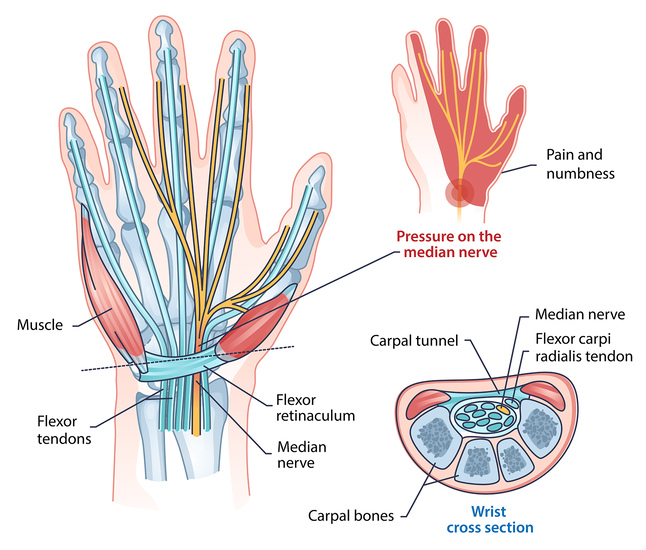/Our services (A to Z)/Musculoskeletal (MSK)/Wrist and hand problems/Known and diagnosed wrist and hand Problems/Carpal tunnel syndrome
About carpal tunnel syndrome
What is carpal tunnel syndrome?
It is where an important nerve (the median nerve) in the hand becomes irritated and sometimes compressed within a tunnel comprising a “U” shaped collection of bones with a tight ligament at the top.

What are the symptoms of carpal tunnel syndrome?
- Pins and needles or tingling commonly affecting the thumb, index, middle and half of the ring finger but can affect the whole hand.
- Sometimes pain is a feature and can spread from the wrist up the arm.
- Symptoms are usually worse in the morning, and it is common for people to wake up and shake their hands until the feeling returns.
- In severe cases there is weakness in the hand and muscle wasting is visible.
Who gets carpal tunnel syndrome?
- It is more common in women with up to 7% of women suffering this problem. Only 1% of men are affected.
- There is often no cause found but it can be related to certain manual repetitive activities.
- It is more common in pregnancy.
- It is also seen in patients with rheumatoid arthritis, renal failure, diabetes and hypothyroidism (underactive thyroid).
- Following a fracture in the wrist region.
How is carpal tunnel syndrome diagnosed?
- Your description of the symptoms and the history.
- Physical examination and tests to reproduce your symptoms.
- Most patients do not require further investigations to diagnose carpal tunnel syndrome.
- A small number of patients may require nerve conduction studies if the diagnosis is unclear following examination and history taking.
How is carpal tunnel syndrome treated?
- Activity modification.
- Splint, often worn at night-time, works especially well during pregnancy.
- Injection of steroid.
Will I need surgery?
Surgery is recommended if:
- you have had the problem for a long time;
- your symptoms are severe
- non-surgical treatments have failed
- the clinician treating you detects wasting of muscles or marked loss of sensation in the hand.
Surgery involves cutting the ligament over the tunnel to relieve the pressure on the nerve. The operation is usually performed under local anaesthetic


